An outline of a Good Friday service that young people led at Salisbury Cathedral.

On your marks
At Salisbury Cathedral in 2003 about 40 children and young people led the Good Friday service. Here’s a rough outline of what they did.
Get set
The strength of the service was in the young people’s own contribution – they met during Good Friday and devised the scenes themselves from this framework, then led the service at 4.00 pm that day. I’ve deliberately given bare bones, because the more that springs from your young people’s own reading of the scenes, the better.
The four scenes took place at different points around the Cathedral and the congregation walked from one to the other singing with a small band leading the music.
Even if your church is nowhere near the size of a cathedral, it is worth thinking about taking the congregation on a walk round different parts of your building. Where might the trial take place? Where does it feel intimate enough to pass round bread and wine?
Go!
The link characters are two journalists who are investigating the events of Maundy Thursday and Good Friday. One is cynical and one is more prone to believing Jesus might be who he says he is. They’re undercover for Jerusalem TV. These two could have microphones if you need them.
Scene 1 (John 13)
In the Upper Room – the journalists sneak into the Last Supper, disguised as slaves, and of course forget to wash everyone’s feet. They watch Jesus do so in amazement. Jesus also shares bread and wine with his friends.
Scene 2 Luke 22:39-52)
The arrest in Gethsemane
The poem ‘John in Gethsemane’ from The Lion Christian Poetry Collection is read.
The two journalists watch Jesus praying and see the arrival of the mob.
Scene 3 (Matthew 27:11-30)
The trial before Pilate
The poem about Pilate’s Wife’s dream from The Lion Christian Poetry Collection is read.
The journalists comment on the crooked trial taking place.
Scene 4 (Mark 15:22-37)
The crucifixion
As Jesus is crucified, the journalists try to decide whether they think Jesus is a complete failure or God’s Son. We also used the acrostic in The Gospels Unplugged on the crucifixion (p. 129) with the initial letters held up by the characters as the poem was read out.
A prayer was said by the minister at the end of each scene, arising from what had just been enacted.

 Download
Download